The Golden Dome: Empire Overhead, Privatization Below
From subscription-based missile defense to billion-dollar AI targeting, America’s latest shield is less about protection and more about privatizing national security.
“We will truly be completing the job that President Reagan started 40 years ago forever, ending the missile threat to the American homeland.” — President Donald Trump on May 20, 2025, as he unveiled the Golden Dome.
In a televised Oval Office address, Trump promised “all of them will be knocked out of the air,” touting a $25 billion down payment on a $175 billion system, with Canada reportedly seeking to join. Yet independent estimates soar into the hundreds of billions, if not trillions—and the real story lies not in the missiles, but in who stands to profit.
More than 360 companies, led by Elon Musk’s SpaceX, Peter Thiel’s Palantir, and Palmer Luckey’s Anduril, are already competing for contracts under a fast-tracked process that bypasses traditional oversight. The project follows a broader Trump-era trend: the privatization of public infrastructure, from mail delivery to immigration enforcement to humanitarian aid.
Senators like Jeanne Shaheen have raised red flags over ethical conflicts, particularly Musk’s dual role as a presidential advisor and potential contractor. The pattern mirrors familiar playbooks, most recently in Gaza, where privatized “aid” systems like the Gaza Humanitarian Foundation leveraged Starlink and Palantir tools to control movement, not deliver relief.
As the Golden Dome moves from speech to strategy, this investigation examines its deeper architecture: not a shield, but a platform empire in the making where billionaires profit from selling the illusion of safety while pushing the world closer to strategic instability and massive surveillance.
A Missile Shield in Name Only
From its inception, the Golden Dome was sold as a myth a “fortress in the sky” to make America untouchable. On January 27, 2025, President Donald Trump signed Executive Order 14186, directing the Department of Defense to build a “next-generation missile defense shield” capable of neutralizing ballistic, hypersonic, cruise, and even space-launched threats. The system would integrate land, sea, air, and space infrastructure, forming what Trump described as a comprehensive shield over the U.S. homeland.
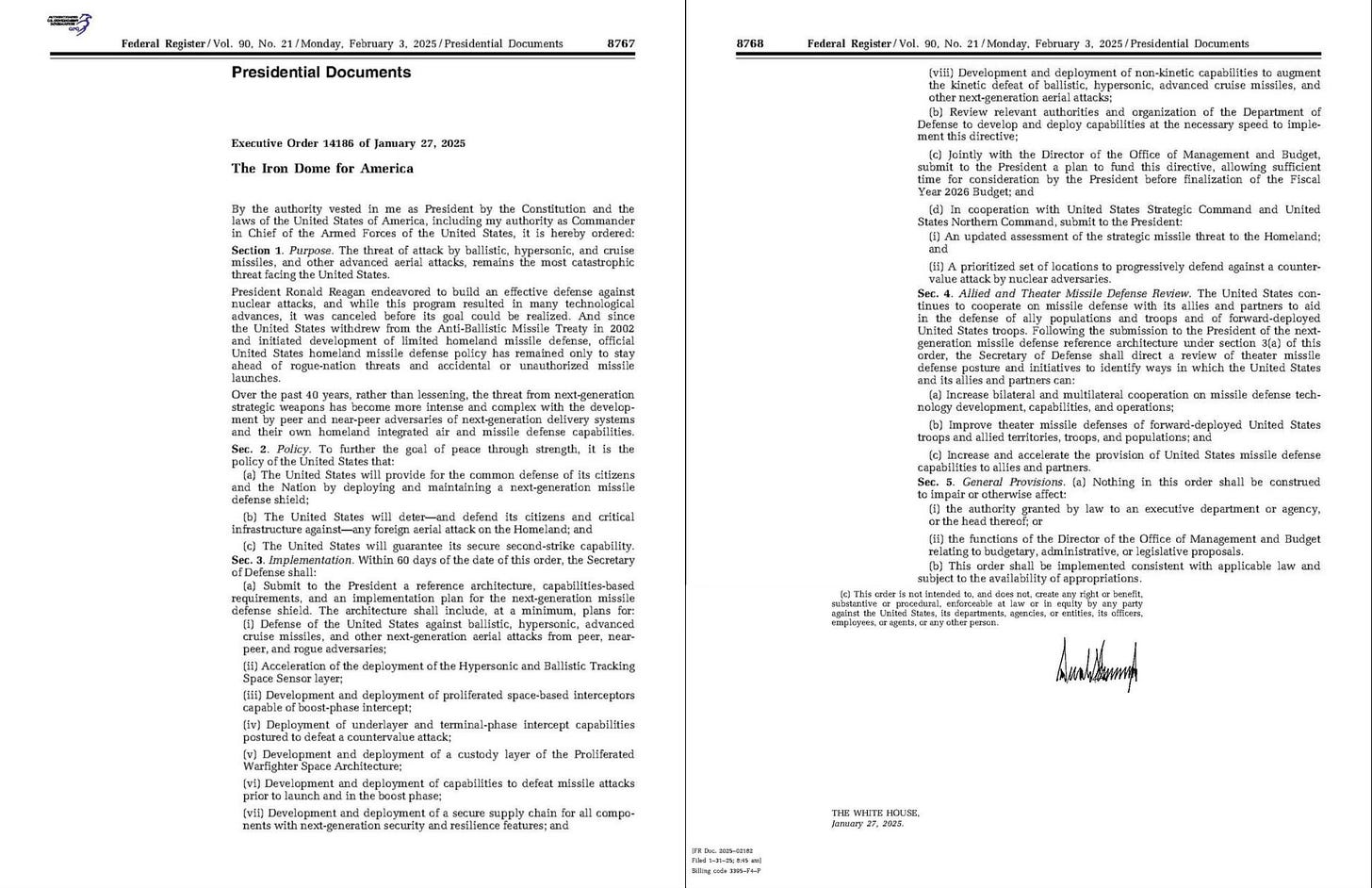
Unlike Israel’s Iron Dome, designed to intercept short-range rockets over a small region, this shield would need to blanket the continental United States and counter advanced weapons moving at over Mach 5. Initially branded as an “Iron Dome for America,” the project was soon renamed the Golden Dome—a symbolic nod to Reagan’s failed Strategic Defense Initiative (SDI) and a rhetorical bridge between Cold War nostalgia and 21st-century technonationalism.
“We helped Israel with theirs, and it was very successful, and now we have technology that's even far advanced from that.” — President Trump
The messaging was pure SDI: total immunity, space dominance, and near-perfect success rates. But the delivery mechanism was not public. This time, it was privatized and delegated to a familiar triad of firms: SpaceX, Palantir, and Anduril.
Within days of the executive order, the Missile Defense Agency (MDA) and the Space Development Agency issued calls for proposals. Over 360 concept papers poured in, according to Defense One—ranging from Lockheed Martin’s layered defense concepts to Booz Allen Hamilton’s “Brilliant Swarms”, a constellation of 1,000+ AI-powered cubesats designed to intercept missiles mid-flight. SpaceX proposed a “custody layer” of 400–1,000 satellites to track incoming warheads offered on a subscription basis, where the Pentagon would pay for access rather than own the system outright. Read that again.

The defense sector’s enthusiasm was immediate. Lockheed Martin launched a full Golden Dome microsite, calling it a “Manhattan Project–scale mission.” Palantir promised precision AI integration, while Anduril pitched autonomous drone swarms as part of the system’s architecture. What emerged was not just a missile defense proposal, it was a privatization stampede, echoing Trump-era moves to offload public services: USPS logistics, humanitarian aid, refugee processing, even mail scanning.
In Gaza, privatized “aid” enabled by firms like Palantir and Starlink transformed humanitarian relief into biometric surveillance. In Latin America, U.S. tech contractors embedded themselves in national infrastructure under the banner of modernization. Now, Golden Dome applies the same logic to the U.S. homeland: security as service, offered by billionaires, funded by the state, and shielded from oversight.
That lack of oversight was very apparent from the start. The EO set out four “epoch” timelines, the first demanding demonstrable capability by December 2026. But it included no feasibility thresholds, no requirement that the system actually work.
Experts quickly flagged that it wouldn’t. Physicist Laura Grego, part of an American Physical Society panel, warned that intercepting just 10 North Korean ICBMs would require over 16,000 space-based interceptors. Arms control analyst William Hartung called Golden Dome “a contractor’s dream, not a strategic necessity,” referencing SDI’s $30 billion implosion. Even defense-aligned analysts on X voiced doubts: “Dead on arrival without trillion-dollar buy-in,”one posted.
Trump surrogate Pete Hegseth, meanwhile, framed Golden Dome as both a legacy project and an ideological tool, comparing it to curren hot button, border security and praising Trump’s foresight in founding the Space Force. The message seemed to convey that this isn’t just defense it’s reclaiming control.
But what it really signals is a shift in what defense even means. Golden Dome is not a shield it’s a procurement pipeline, designed around imagery and ideology, not physics or deterrence. It turns national security into an app-based ecosystem.
The Contractors Have Landed
If Reagan’s Strategic Defense Initiative was a public bluff dressed in lasers, the Golden Dome is a private land rush dressed in satellites. Within days of Executive Order 14186, the Pentagon issued calls for industry proposals. What followed was not strategic planning but a bidding frenzy: over 360 companies submitted concept papers, offering everything from space-based interceptors to drone-integrated kill chains. At the front of the pack: SpaceX, Palantir, and Anduril—three companies at the nexus of tech ambition, military contracts, and political power.
SpaceX, Elon Musk’s rocket and satellite empire, emerged as the likely architect of the custody layer, a mesh of 400 to 1,000 low-Earth orbit satellites designed to detect and track missiles globally. But instead of selling the system to the government, SpaceX offered a subscription model: the U.S. would pay to access satellite tracking, not own it.
The Pentagon would essentially rent national defense. Does this mean other countries can too?
As Reuters reported, this model raised internal concerns. The U.S. could lose control over upgrade timelines, costs, and even operational independence. Yet SpaceX’s existing infrastructure, its Starlink mega-constellation, Falcon 9 rockets, and Starshield platform, gave it a technical advantage no other firm could match.
What made the deal more fraught was Musk himself. As a Special Government Employee, he was formally advising Trump on government efficiency while simultaneously bidding for one of the largest defense contracts in U.S. history. Senator Jeanne Shaheen has since introduced legislation that would prohibit federal contracts from going to companies owned by special government employees—a direct response to Musk’s dual role.
Peter Thiel’s Palantir, long embedded in U.S. defense and intelligence infrastructure, is expected to lead the sensor fusion and targeting component. Its software will integrate satellite data, radar feeds, drone footage, and other inputs to algorithmically decide which missiles get intercepted… and when.
This is not speculation. Palantir has already partnered with SpaceX on military sensor mesh trials and has pushed aggressively to be the “AI layer of war.” The company’s Gaza involvement, via the Gaza Humanitarian Foundation (discussed thoroughly in my previous article) and biometric logistics platforms, shows how easily “humanitarian tech” turns into surveillance tech. Golden Dome gives Palantir a homeland theater to expand those systems.
Founded by Oculus creator Palmer Luckey and backed by Thiel’s Founders Fund, Anduril built its name on autonomous border surveillance towers and drone platforms. In the Golden Dome pitch, it’s expected to provide ISR systems—intelligence, surveillance, and reconnaissance—alongside autonomous drone interceptors and decision-making software.
Anduril’s business model is Silicon Valley 101: raise venture capital, promise disruption, and capture government markets. It has already replaced traditional defense primes in contracts along the U.S.–Mexico border and in Pacific drone patrols. Golden Dome gives it an opportunity to scale to global command architecture.
Even legacy contractors are reinventing themselves to fit the privatized tech narrative. Booz Allen Hamilton proposed “Brilliant Swarms”—a constellation of 2,000 satellite interceptors operating as a decentralized kill network, using AI to make targeting decisions in milliseconds. The company claimed the system could be fielded for $25 billion. But leaked internal estimates suggested it would only reliably intercept two missiles.
Contracts First, Questions Later
What unites these firms isn’t just technology, it’s ideology. They sell platforms, not weapons. Access, not ownership. Their systems aren’t built for democratic accountability or multilateral stability. They’re built for speed, control, and revenue.
As with aid in Gaza and AI surveillance in Latin America, the U.S. government is again handing core state functions to companies with zero electoral oversight. And unlike traditional arms manufacturers, these firms operate like startups: agile, vague, and structurally unaccountable.
The momentum is already baked in, skeptics be damned. The Golden Dome is being framed as a generational investment, a moonshot, a security imperative. Yet its architecture reflects something else entirely: a platform empire under construction, built by billionaires, funded by taxpayers, and shielded by patriotism.
Reagan’s Dream, Venture Capital’s Reality
When President Trump declared on May 20 that “we will truly be completing the job that President Reagan started 40 years ago,” he framed the Golden Dome as the fulfillment of the Strategic Defense Initiative (SDI)—Reagan’s 1983 vision of space-based lasers capable of neutralizing Soviet missiles before they reached American soil. But SDI was never meant to be built. It was theater, a bluff intended to drain Moscow’s will and wallets. It collapsed under its own technological and fiscal weight. The Golden Dome is different in one dangerous way…. this time, the money is real, or at least it seems so.
SDI was a Cold War myth wrapped in typical Reaganite optimism. It spent $30 billion across a decade and failed to produce a single operational system. It never left the gound, but it didn’t need to its real value was symbolic. It rattled the Soviet Union and gave the illusion of strategic invincibility. But Reagan’s dream was a public-sector project, debated in Congress, constrained by public budgets, and largely contained within the Pentagon.
Trump’s Golden Dome, by contrast, is a privatized version of the same illusion but stripped of oversight, inflated with investor capital, and pitched by companies that behave more like Silicon Valley disruptors than military contractors. The Reagan-era fakery has become a subscription service, propped up by fast-tracked contracts and algorithms promising battlefield miracles.
The American Physical Society, in a 2025 review, concluded that intercepting even a limited North Korean ICBM strike—say, 10 warheads—would require 16,000 space-based interceptors. The logistics alone would be staggering. The cost? Between $300 billion and $2.5 trillion, depending on scale and ambition. And that’s if the system works, which no missile defense system, space-based or otherwise, has reliably done at scale.
But unlike the SDI era, Golden Dome contractors aren’t just taking government checks to run simulations. They’re selling platforms:
Anduril markets autonomous drones and decision-making software that promise to eliminate human latency in intercepts.
Palantir pitches a centralized AI brain capable of fusing data from radar, drones, satellites, and sensors.
SpaceX wants to build and maintain the entire satellite infrastructure under a pay-to-access model, effectively turning missile defense into a software license.
The technological claims are no more grounded than SDI’s space-laser promises. But the financial and political pipeline is stronger, faster, and less transparent. Venture capital flows in. Government money follows. Press releases turn into policy. And in the background, the same handful of figures—Musk, Thiel, Luckey—appear again and again.
What SDI tried to do with Star Wars metaphors, the Golden Dome does with platform speak. “Custody layers,” “kill webs,” “tracking tranches,” and “epoch delivery milestones” replace lasers and shields. The Cold War’s military-industrial complex has morphed into a data-driven, AI-powered contractor ecosystem, where accountability is abstract, timelines are blurred, and cost projections are effectively meaningless.
This is not a revival of Reagan’s deterrence strategy. It’s the repurposing of Reaganite theater to justify a techno-corporate reordering of defense itself.
Reagan used the illusion of space defense to destabilize a rival empire.
Trump is using that same illusion to empower a domestic one.
And unlike in the 1980s, this new empire is not state-run. It is privately owned, algorithmically managed, yet politically protected. There are no congressional debates over line-item feasibility. Just executive orders, PowerPoints, and a lot of really nice branding.
SDI ended in budget cuts and quiet failure. Golden Dome is on track to end in surveillance infrastructure, unfulfilled promises, and most importantly, massive transfers of public wealth into private portfolios. One was a fantasy meant to be believed. The other is a fantasy meant to be billed.
How Much for a Mirage?
In his May 20 speech, President Trump promised the Golden Dome would be “fully operational before the end of my term,” calling it “the best system ever built.” He announced a $25 billion initial investment, describing it as a “beautiful bill” and a patriotic down payment on a broader $175 billion national shield. But independent estimates suggest that’s only the beginning and may not even cover the first round of satellites.
According to projections from the American Physical Society, intercepting a salvo of just 10 intercontinental ballistic missiles—like those North Korea currently fields—would require over 16,000 space-based interceptors to ensure any credible chance of interception. A 2024 cost analysis from the APS and researchers at the American Enterprise Instituteputs even the most “austere” interceptor system in the $300 billion to $500 billion range. Others estimate a total program cost of $2.5 trillion through 2035, depending on the satellite architecture and interceptor layer.
And even that staggering number may be optimistic.
A 2025 study in Defence and Peace Economics modeled a large-scale missile barrage scenario. If an adversary launched 6,700 to 88,000 warheads—possible for Russia or China, especially with decoys—an advanced two-layer missile defense would cost the U.S. between $430 billion and $5.3 trillion, depending on effectiveness. And that’s assuming only a 50% success rate. By comparison, the entire Pentagon budget for 2025 is $850 billion.
The more warheads launched, the more the economics tilt in favor of the attacker. It is cheaper to build the ladder than the dome (kinda like the infamous wall).
Even internal contractor documents reflect this imbalance. Booz Allen Hamilton’s “Brilliant Swarms” proposal, featuring a constellation of 2,000 AI-powered cubesats for early boost-phase intercept, was estimated to cost $25 billion, yet would only reliably stop two missiles in a real-world scenario, according to one former Pentagon official familiar with the briefings. “It’s an insurance policy that doesn’t pay out,” they said. “But the premiums are great—for the contractors.”
Meanwhile, the Pentagon’s own contracting approach reveals a shift away from accountability. Rather than using competitive bidding with firm requirements, Golden Dome is being procured largely through Other Transaction Authority (OTA) agreements, legal workarounds originally designed for prototyping, now used to fast-track multi-billion dollar systems without public oversight.
In March 2025, the Missile Defense Agency quietly issued an RFI (Request for Information) noting it would explore “non-traditional acquisition models” for Golden Dome. As of April, the MDA was reviewing over 360 concept papers—most of which are not subject to standard auditing or congressional review under OTA law.
OTAs are not new. But using them to assemble a national missile shield is unprecedented.
This model mirrors how Palantir secured control of ICE’s Immigration Operating System and Safe Reach gained biometric control of Gaza’s aid delivery: fast-track approvals, limited competition, and no mandate for outcome-based metrics. The public pays for a speculative system, while the companies extract guaranteed funding, intellectual property rights, and future licensing fees.
The system isn’t just expensive, it’s structurally rigged to deliver value to contractors first. SpaceX’s proposal, for example, offers a “subscription-based” custody layer where the U.S. would pay for access to satellite tracking data instead of owning the infrastructure. This turns Golden Dome into defense-as-a-service, a privatized utility that can be priced, throttled, or repackaged over time—without legislative renewal.
Anduril and Palantir follow similar logic. Their value proposition isn’t performance, but scaling. Just like software startups, they pitch interoperability, AI learning curves, and future “capabilities.” Actual reliability is secondary—winning the contract is the goal.
This isn’t about building a dome. It’s about building a pipeline—a funnel for public wealth into private tech portfolios, all under the camouflage of national defense.
There is precedent for this. The U.S. Postal Service’s restructuring handed logistics contracts to Amazon and FedEx while slashing worker benefits. ICE’s shift to predictive analytics came through Palantir, which offered speed over transparency. Even disaster relief logistics have been privatized through layers of OTA-driven contracting in Puerto Rico, Gaza, and Sub-Saharan Africa.
Golden Dome is simply the largest and most dangerous expression of the model so far. It promises the impossible, avoids measurable benchmarks, and makes room for unproven technologies to secure billion-dollar commitments—all under the banner of urgent national security.
In the end, the real threat isn’t what’s coming from space. It’s what’s leaving our pockets and entering venture-backed defense portfolios, without any guarantee of protection in return.
Who Gets Left Out?
The Golden Dome, despite its celestial name and trillion-dollar ambition, is not a global defense system. It is explicitly designed for the continental United States—a high-tech fortress to shield the mainland from missile attacks. Everyone else, including allies long embedded in American security strategy Japan, South Korea, Israel, NATO partners, Gulf states, are on their own.
The executive order that launched the Golden Dome made no mention of extended deterrence or allied protection. Canada has been floated as a potential co-participant, but even that remains undefined. For the rest of America’s partners, the message is clear, “You’re outside the shield.” And that exclusion carries consequences.
If the U.S. is protected and its allies are not, what incentive do nations like Japan, Poland, or the UAE have to trust in U.S. guarantees? Why wouldn’t they pursue their own nuclear deterrents? Missile defense that works only for Washington could trigger a new wave of proliferation, with allies racing to secure weapons they once believed America would shield them from.
This isn’t just theoretical. Analysts at the Wilson Center and Stimson Center have warned that unilateral missile shields undermine the delicate logic of Mutually Assured Destruction (MAD)—the Cold War doctrine that, paradoxically, kept the peace. MAD assumes that no country will launch a nuclear first strike because it cannot escape retaliation. A functioning Golden Dome, or even the perception of one, upends that equation.
A nation that believes it can strike without consequence, or survive a strike without response, is more likely to escalate.
Russia and China know this. Their response is already underway. Russia has expanded its MIRV programs—warheads that split into multiple independently targeted reentry vehicles, overwhelming defenses. China is deploying hypersonic glide vehicles that can maneuver mid-flight, evading satellite tracking. Both nations are investing in anti-satellite weapons, aiming to blind U.S. space-based systems before a conflict evenins.
And heres the second tier of instability: boost-phase interception, one of Golden Dome’s core promises, requires U.S. satellites to loiter over adversary territory—tracking missiles during the first 3 to 5 minutes of flight. That means putting U.S. military assets permanently above Russia and China, a move neither will tolerate.
In other words, the Golden Dome could escalate tensions before it’s even built.
Meanwhile, the U.S. public has been sold the idea of invulnerability, while those outside the dome, both foreign allies and marginalized communities at home, are left to absorb the risks. This tiered protection model isn’t new. In Gaza, the biometric aid system designed by U.S.-linked firms like Palantir promised order but delivered surveillance and restricted mobility for Palestinians. In Latin America, U.S. tech contractors embedded in police, migration, and health systems have created security bubbles for elites and foreign interests, not the public.
Golden Dome follows the same logic: security is for subscribers. The rest live with consequences.
Domestically, this manifests in militarized border zones, biometric containment systems, and predictive surveillance. Abroad, it means pushing allies into nuclear dilemmas while pretending strategic stability still exists. The private firms building Golden Dome are not bound by alliance treaties, diplomatic nuance, or nuclear ethics. Their only deliverable is product and their customers are not populations, but procurement officers.
Golden Dome doesn’t just leave out allies. It leaves out the public interest entirely.
The promise was peace. The result is division: between those who are “inside the dome” and those who are not, between defense that protects and defense that destabilizes, and between the illusion of safety and the very real architecture of exclusion.
Platform Empire, Homeland Edition
The Golden Dome isn’t just a missile shield—it’s a platform. A convergence point where defense, surveillance, and privatized governance fuse into something far more durable than any interceptor. This is not just Reagan’s fantasy upgraded by Musk.
The firms behind the Golden Dome—Palantir, Anduril, SpaceX—aren’t new to this model. They’ve already piloted it abroad.
Palantir has been reported to supply AI-driven targeting systems to Israel, facilitating military operations in Gaza. SpaceX’s Starlink service has been offered to aid organizations in Gaza, though official deployments never occurred. Currently, SpaceX is a leading contender to develop the ‘custody layer’ of the Golden Dome missile defense system, proposing a new constellation of satellites dedicated to missile detection and tracking.

In Latin America, Anduril and Palantir have embedded themselves in migration control systems, border surveillance contracts, and regional “stability” operations. In Honduras, El Salvador, and Colombia, biometric data platforms and autonomous drone towers monitor rural zones once policed by national forces. The pattern is simple: swap public infrastructure with contractor-administered platforms, then sell the model back to Washington as security innovation. Now, the very same actors are bringing that mohome.
Golden is its most literal expression. A mesh of satellites, AI interfaces, and autonomous sensors that promise deterrence but function as an always-on operating system for American airspace. SpaceX calls it the “Starshield” backbone. Palantir calls it sensor fusion. Anduril calls it autonomous ISR. But what they’re really building is an invisible, privatized latticework of control—from orbit to infrastructure.
This isn’t hypothetical. The Pentagon has already acknowledged that Golden Dome will integrate with FEMA disaster tracking, NORAD command, and Homeland Security’s ISR feeds. The result is a fluid, interoperable data stack connecting wildfire management, border tracking, and missile intercept decisions. The surveillance logic honed abroad has been normalized and scaled into domestic policy.
Anduril’s drones, deployed over the Arizona desert, once surveilled asylum seekers. Now they’ll monitor missile trajectories and potentially, “homeland integrity.” Palantir’s AI, once used to sort humanitarian aid recipients in Gaza, will now sort launch paths, warhead trajectories, and possibly make targeting decisions in real time.
This shift parallels what we’ve already seen across USPS, ICE, and FEMA. These institutions, once public services, have been hollowed out and refitted as subscription platforms for private contractors. USPS now rents sorting infrastructure from Amazon and FedEx. ICE runs predictive enforcement software built by Palantir. FEMA relies on contractor-run analytics dashboards during emergencies.
Golden Dome simply extends that logic to its most high-stakes frontier: strategic defense. What was once a domain of state responsibility is now packaged and licensed like cloud computing.
For decades, “homeland security” was a slogan. With Golden Dome, it becomes a business model fused with orbital surveillance, AI decision-making, and private control over public infrastructure.
And like all platforms, it will grow as it’s meant to. What begins as missile tracking will expand to border management, riot prediction, biometric tagging, and disaster logistics. The architecture is already there. What’s new is its consolidation, branding, and rollout as a unified, privately-owned national shield.
But shields don’t just block—they define what lies within and what lies without. Who gets protected. Who gets surveilled. Who gets left out.
Golden Dome isn’t just about stopping missiles. It’s about cementing a privatized platform empire, where national security, civil infrastructure, and public trust are no longer administered by the state—but by contract, by license, by proprietary algorithm.
And if that sounds like Gaza, or the Sahel, or Colombia, it’s because it is.
A Dome Without a Roof
When President Trump promised a 100% success rate and the end of the missile threat “forever,” he was selling a story. A resurrection of Reagan’s dream, recast with billionaires and orbital subscriptions, packaged for a public hungry for certainty in uncertain times. The Golden Dome was never just about defense. It was, and remains, a mirage of protection designed to funnel public trust and public money into the hands of private contractors.
We’ve seen this story before. In Gaza, biometric containment was marketed as humanitarian logistics. In Latin America, AI surveillance was branded as modernization. And now, over American skies, the same firms, Palantir, SpaceX, Anduril, are selling a dome. Not one made of steel or certainty, but of influence, contracts, and control.
The costs are astronomical. The technology is unproven. And the oversight—like so many privatized ventures before it—is nearly nonexistent. But the profits are guaranteed: locked in by executive order, laundered through patriotic branding, and scaled through subscription models. Missile defense is no longer a public safeguard—it’s a private product, sold in tranches, licensed like software, and governed by shareholders, not citizens.
And what’s being built is not a dome it’s an architecture of exclusion. One that leaves allies exposed, accelerates global arms races, and turns military surveillance inward. It will not stop war. It will not secure peace.
The Golden Dome won’t protect the people it claims to serve. It will shield power, entrench profit, and expand empire not outward, but inward, over the very public it pretends to defend.
And that, in every way that matters, makes it a dome without a roof.





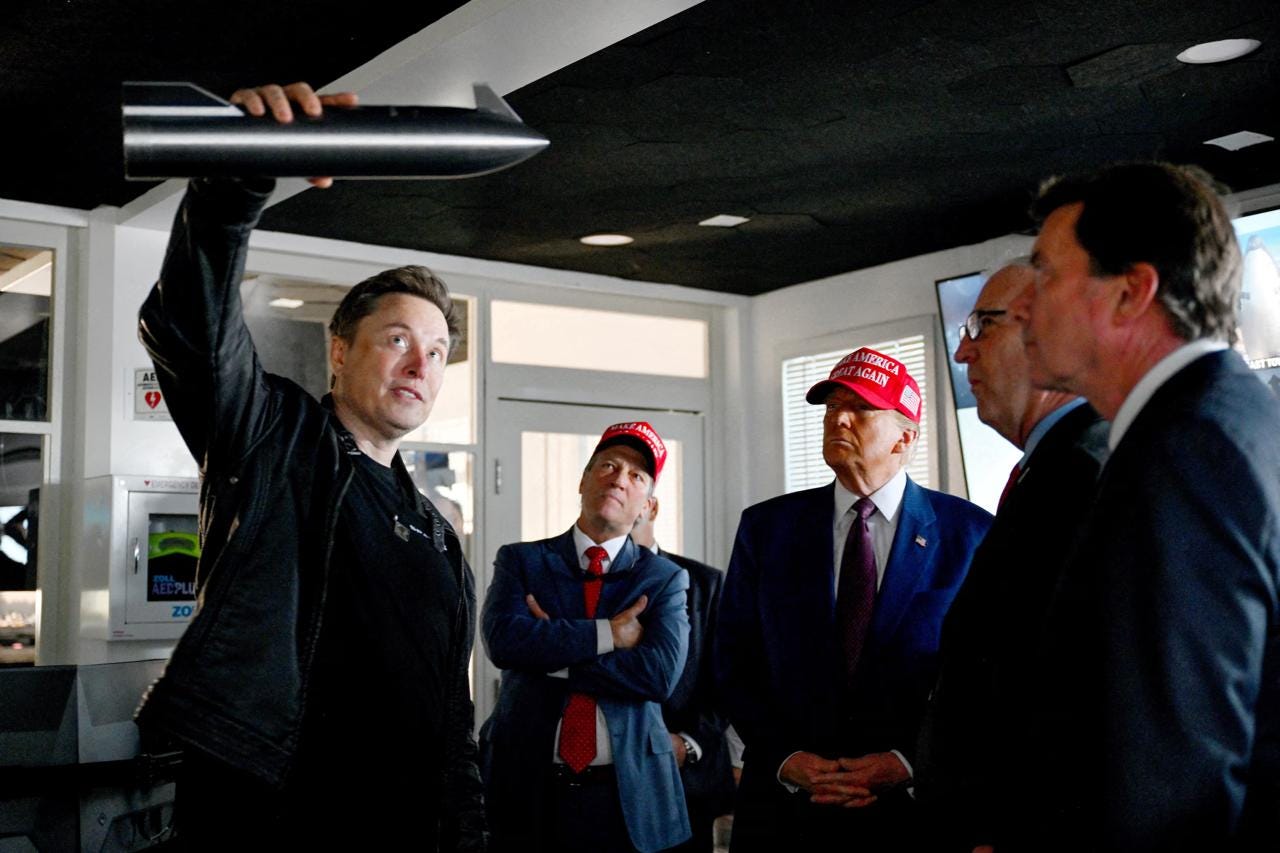


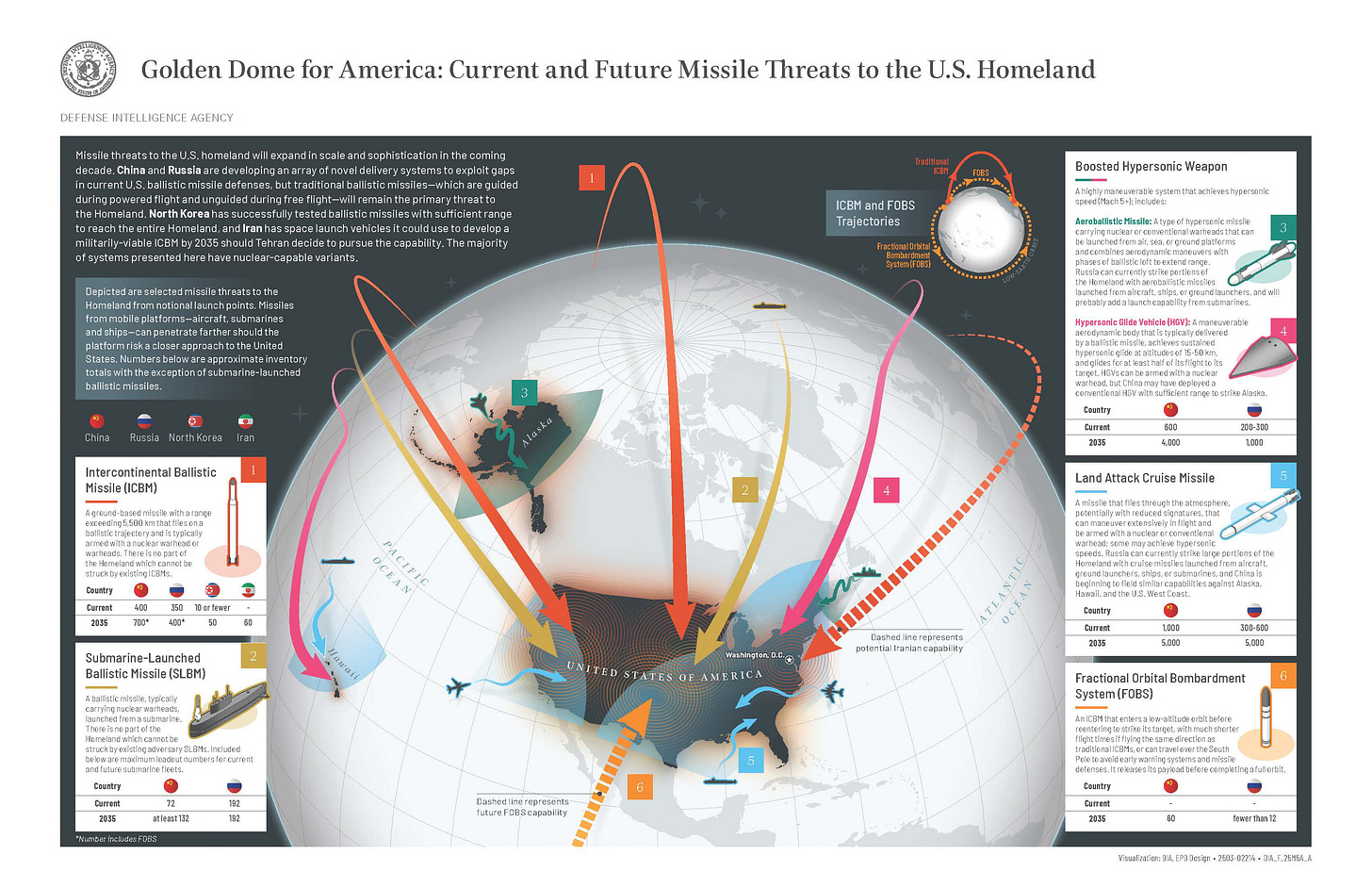
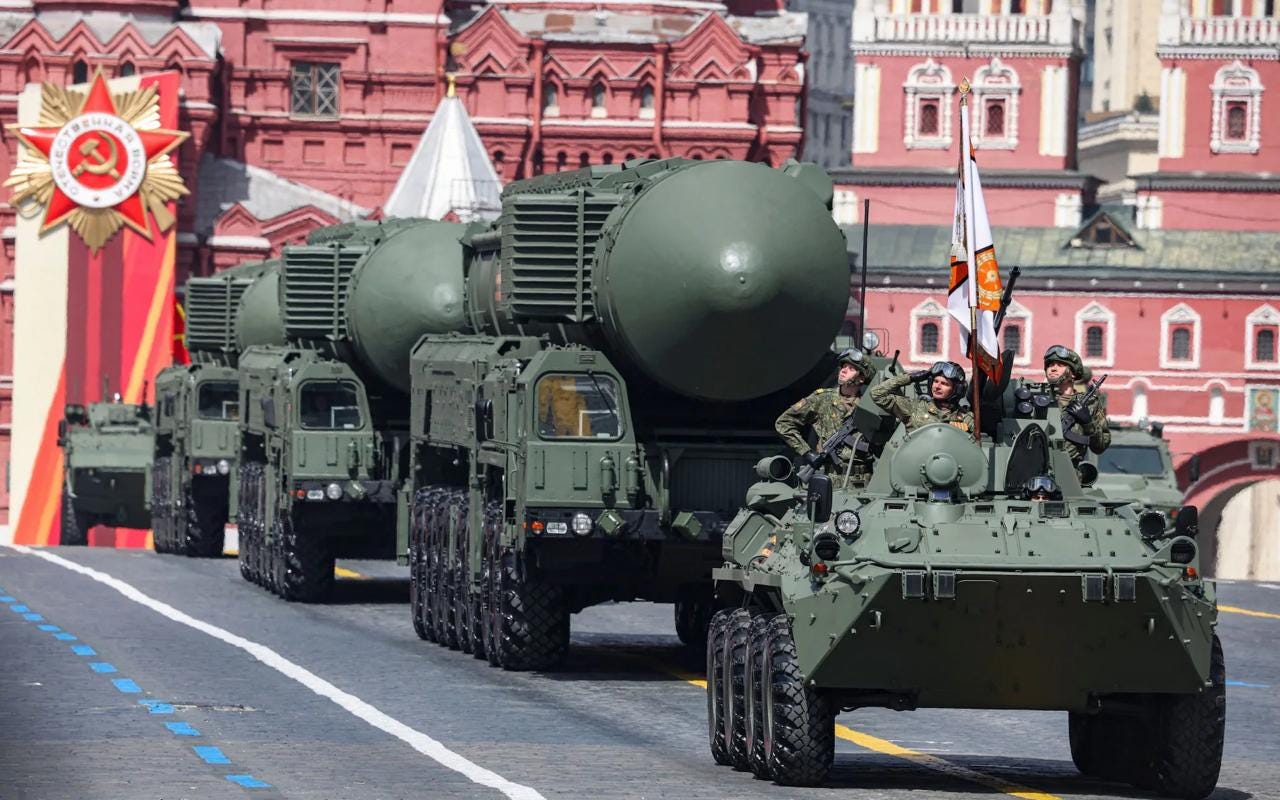
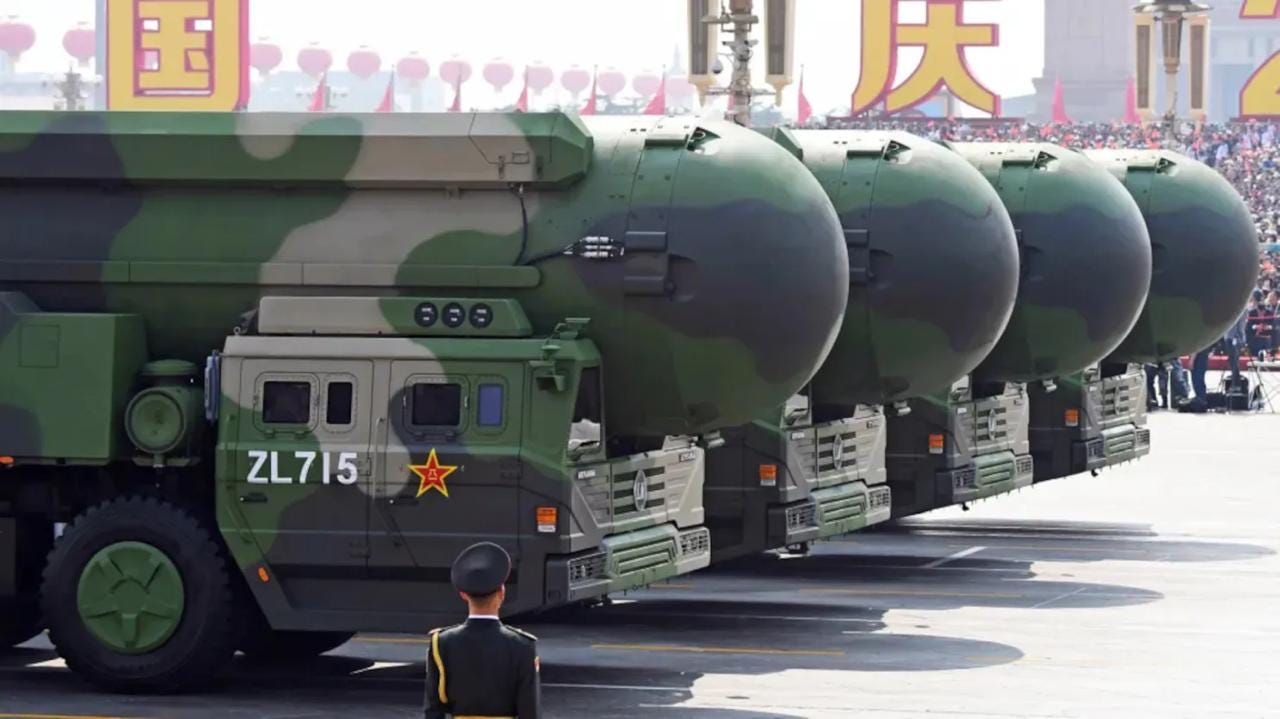
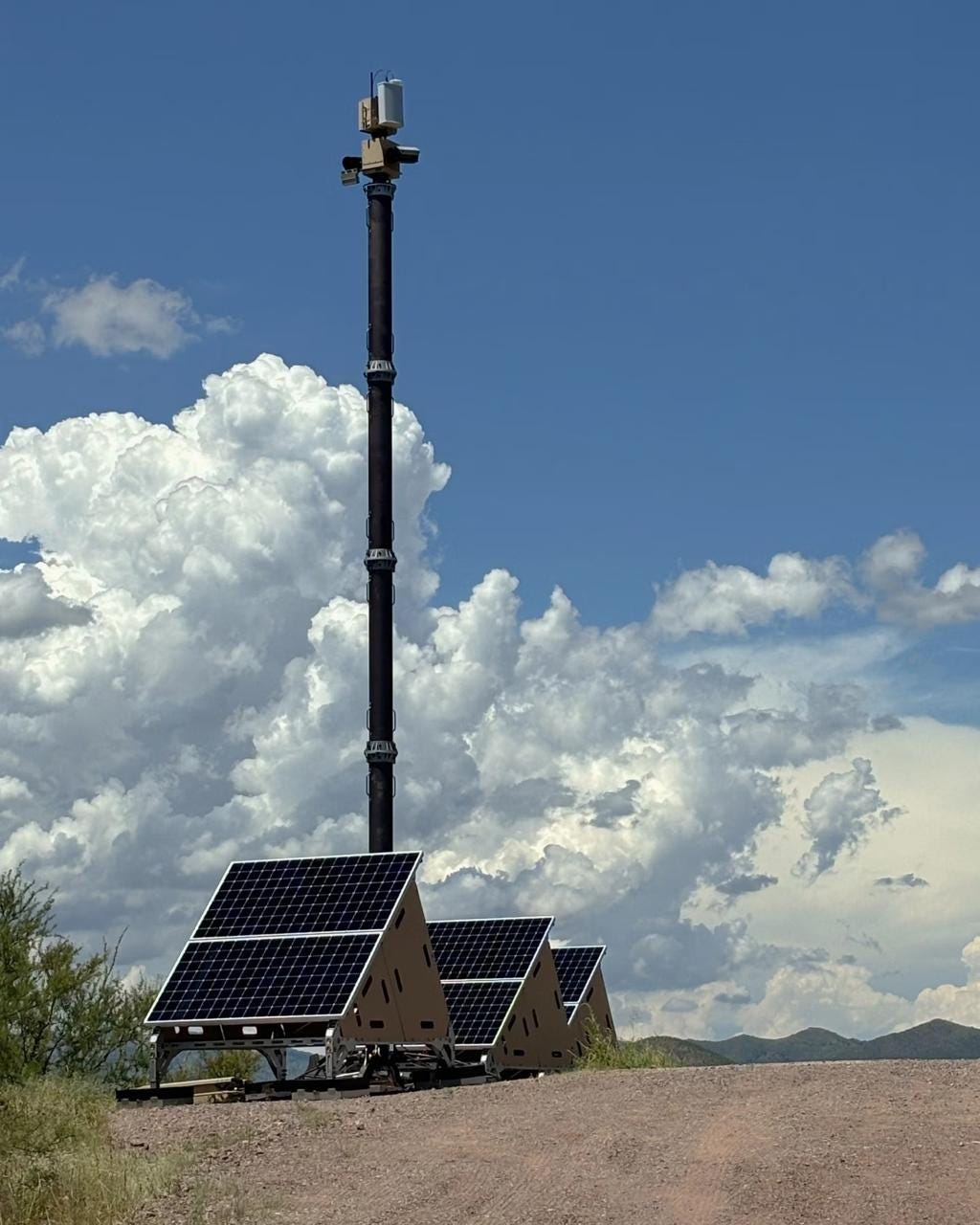

DJT learned a lot from his first Presidency. 1. He determines nothing and that's left to "the sydicate" of bankers, corporate lawyers, think-tanks, corporations and donors 2. He's made the Presidency his personal cash machine for him and his cronies enriching all of them going around the world shaking them down like a true thug. 3. The more ludicrous the idea, the more the MAGA-cult drinks up the kool-aid.
I go from incredulity, revulsion, tears for the dying, and trying to burn off my anger. In other words, he's driving the world into not only financial meltdown but complete madness.